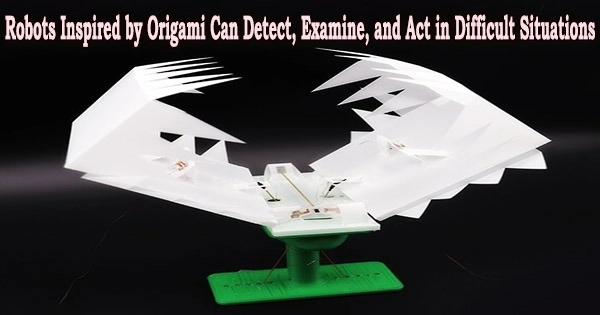Roboticists have been creating autonomous machines out of thin, flexible sheets using a method resembling the age-old craft of paper folding. These portable robots are easier and less expensive to construct, and they are smaller and easier to store and travel.
The stiff computer chips, however, add extra weight to the thin sheet materials and make them more difficult to fold. These rigid computer chips are generally required to enable advanced robot functions, such as perceiving, analyzing, and responding to the environment. Hence, the semiconductor-based parts must be inserted after a robot has assumed its final form.
A multidisciplinary team now has developed a novel fabrication method for totally foldable robots that can carry out a range of difficult tasks without the need of semiconductors, under the direction of scientists from the UCLA Samueli School of Engineering. The results of the investigation were published in a study in Nature Communications.
The researchers developed a system of information-processing units, or transistors, that can be combined with sensors and actuators by embedding flexible and electrically conductive materials into a pre-cut, thin polyester film sheet. The sheet was then programmed with basic computer analog capabilities that mimic semiconductor functions.
The sheet was sliced, folded, and put together to create an autonomous robot that can precisely sense, evaluate, and react to its surroundings. The researchers named their robots “OrigaMechs,” short for Origami MechanoBots.
The robots could be designed for specialty functions and manufactured on demand very quickly. Also, while it’s a very long way away, there could be environments on other planets where explorer robots that are impervious to those scenarios would be very desirable.
Ankur Mehta
“This work leads to a new class of origami robots with expanded capabilities and levels of autonomy while maintaining the favorable attributes associated with origami folding-based fabrication,” said study lead author Wenzhong Yan, a UCLA mechanical engineering doctoral student.
OrigaMechs derived their computing capabilities from a combination of mechanical origami multiplexed switches created by the folds and programmed Boolean logic commands, such as “AND,” “OR” and “NOT.” The switches made it possible for a system to selectively output electrical signals in response to the varying pressure and heat input.
Using the new approach, the team built three robots to demonstrate the system’s potential:
- an insect-like walking robot that reverses direction when either of its antennae senses an obstacle
- a Venus flytrap-like robot that envelops a “prey” when both of its jaw sensors detect an object
- a reprogrammable two-wheeled robot that can move along pre-designed paths of different geometric patterns
The long-term objective, according to the researchers, is to equip the autonomous origami robots with an embedded energy storage system powered by thin-film lithium batteries, even though the robots were tied to a power source for the demonstration.
The chip-free architecture might make it possible for robots to operate in harsh settings with high magnetic or radiative fields, intense radio frequency signals, or severe electrostatic discharges where conventional semiconductor-based electronics might not be able to.
“These types of dangerous or unpredictable scenarios, such as during a natural or humanmade disaster, could be where origami robots proved to be especially useful,” said study principal investigator Ankur Mehta, an assistant professor of electrical and computer engineering and director of UCLA’s Laboratory for Embedded Machines and Ubiquitous Robots.
“The robots could be designed for specialty functions and manufactured on demand very quickly,” Mehta added. “Also, while it’s a very long way away, there could be environments on other planets where explorer robots that are impervious to those scenarios would be very desirable.”
By using this adaptable cut-and-fold method, pre-assembled robots could be shipped in flat packaging, saving a significant amount of space. In situations like space missions, where every cubic centimeter counts, this is crucial. The low-cost, lightweight, and straightforward fabrication of the robots may potentially result in the creation of novel teaching aids or brand-new toys and games.
Other authors on the study are UCLA undergraduate student Mauricio Deguchi and graduate student Zhaoliang Zheng, as well as roboticists Shuguang Li and Daniela Rus from the Massachusetts Institute of Technology.
The National Science Foundation supported the research. Yan and Mehta are applying for a patent through the UCLA Technology Development Group.





